Top 6 Discoveries Of Cassini As Its 20-Year Mission Comes To An End
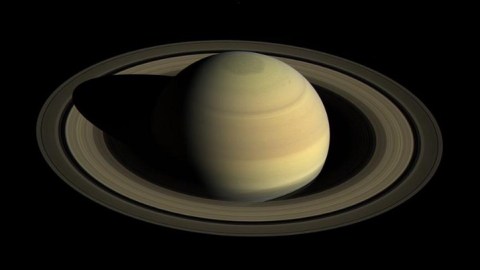
Last week, Cassini plunged into Saturn’s atmosphere. Here are the top 6 things we learned from it while it was alive.
“Being a scientist and staring immensity and eternity in the face every day is as grand and inspiring as it gets.” –Carolyn Porco
Of all the planets in the Solar System, the one that first became a mystery to skywatchers goes as far back as the invention of the telescope itself. When Galileo first used his earliest magnifying device to view the heavens, Venus exhibited the full suite of phases; Mars went from gibbous to full and back again; always-full Jupiter revealed its largest moons to us; but Saturn was an enigma, appearing to display “ears” as Galileo noticed them. Over the years, it became that Saturn was even more wondrous, exhibiting rings with gaps in them, many moons of various sizes and other interesting properties, banded structures, transient storms and much more. The advent of modern telescopes and the Voyager fly-bys of Saturn only exposed even deeper mysteries, opening up a plethora of curious questions.
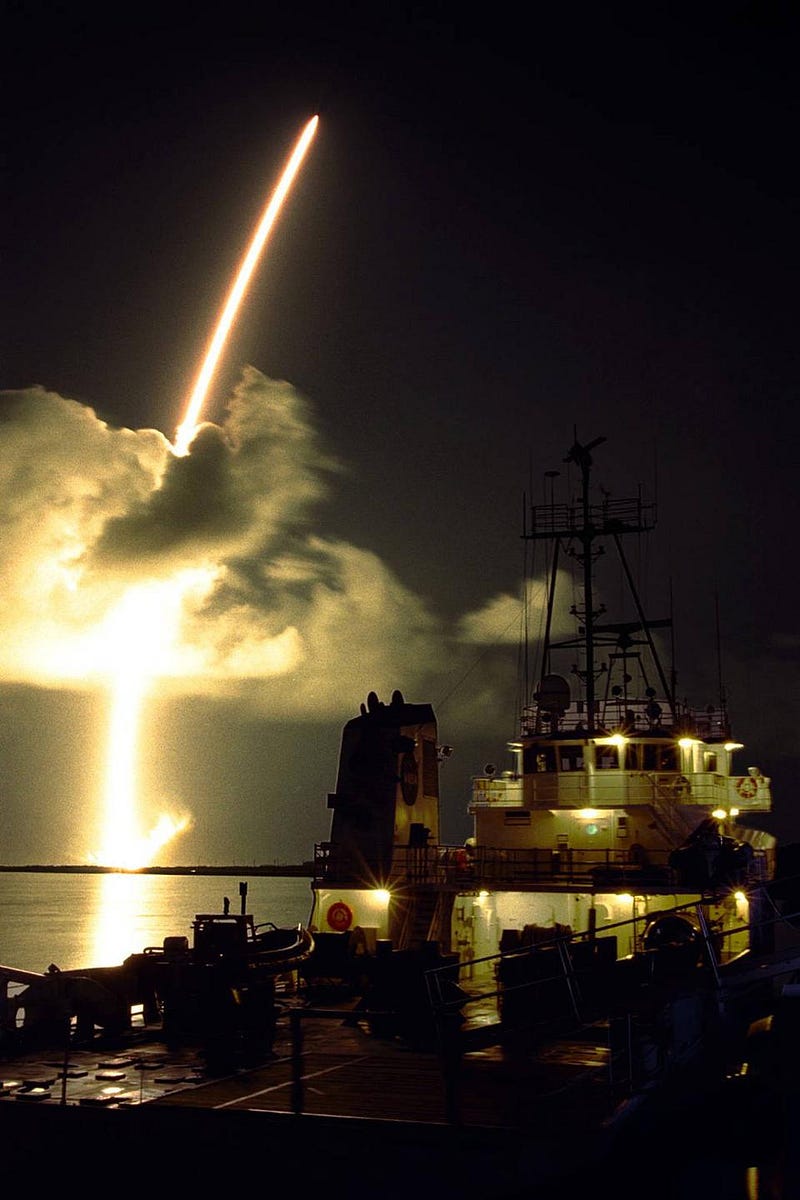
On October 15, 1997, the first dedicated mission to the planet Saturn, NASA’s Cassini, was launched. Intended to view the ringed planet, take images and spectra of the world, its rings and its moons, it was also equipped with a lander: the Huygens probe, which would descend down onto Saturn’s giant moon, Titan. Outfitted with a radioisotope generator, it would have its own onboard power from nuclear decay that would last for decades, allowing for unprecedented science-at-a-distance to be done.
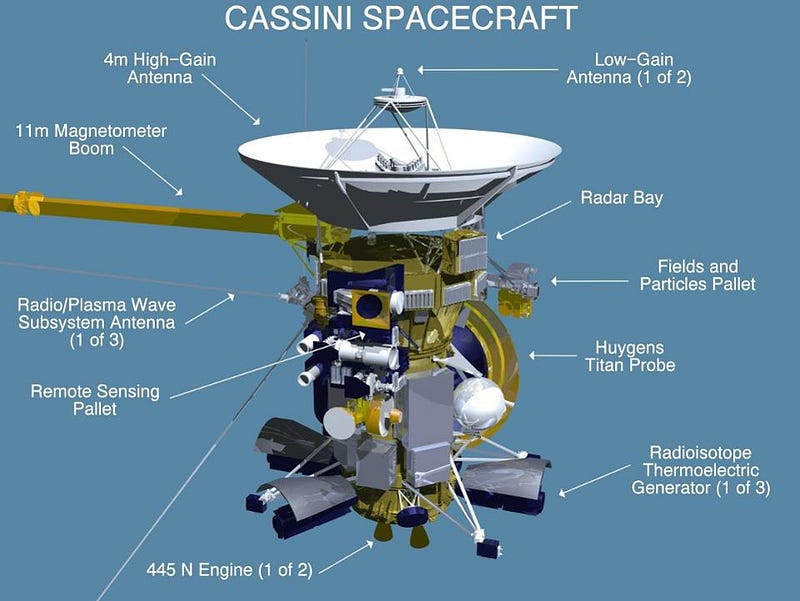
Cassini reached its destination in 2004, after a seven year journey through the Solar System. When it arrived at Saturn, it immediately began taking data and completed its four-year primary mission without a hitch in 2008. It discovered additional gaps in Saturn’s rings, storms and swirling patterns on the Saturnian surface, additional moons, found the presence of a variety of molecules, and the Huygens probe even found evidence of flowing, liquid methane on Titan’s surface. Yet despite these tremendous successes, six discoveries stand out as the most spectacular of the Cassini mission. Now that it’s reached the end of its life, here are the greatest ones of all.
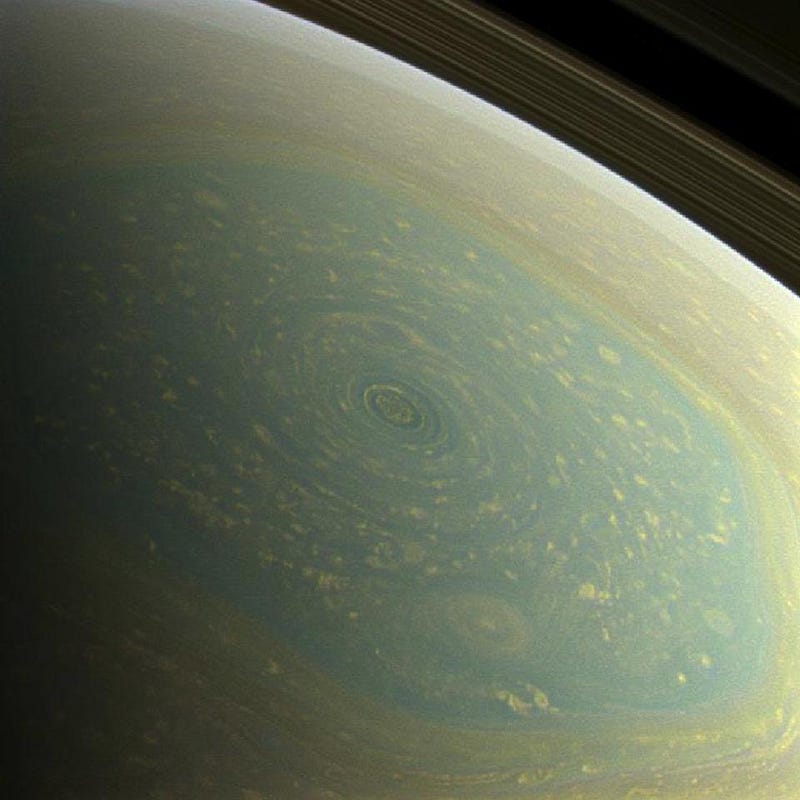
1.) Saturn’s polar hexagon and hurricane. Although hints of such a structure were found by Voyager, it wasn’t until Cassini imaged it that we discovered the spectacular truth: Saturn has a hexagonal storm that rages continuously around its north pole. A consequence of fluid dynamics and Saturn’s chaotic but rapidly-rotating atmosphere, this is the first such storm ever discovered on a gaseous world. Over 32,000 km (20,000 miles) wide, the storm starts at 78º latitude and extends down for some 100 km (60 miles).
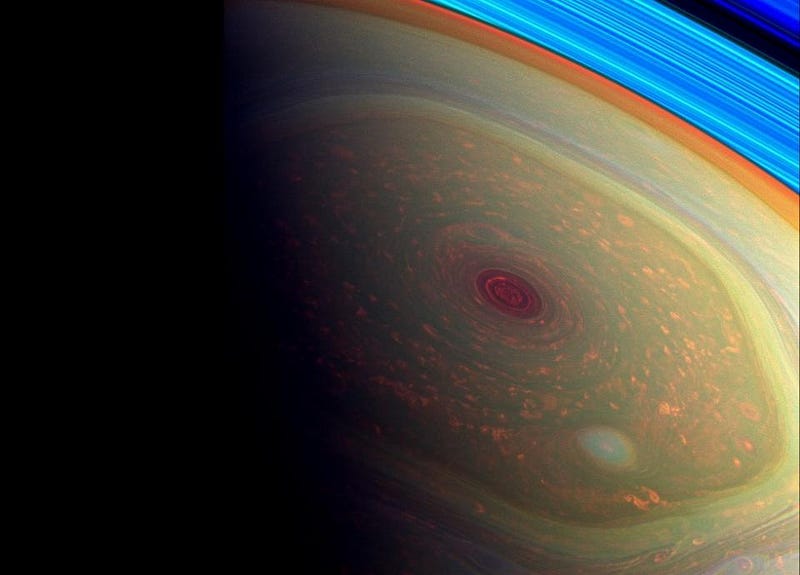
Unlike other atmospheric features, the hexagon does not vary in latitude as time goes on. An east-moving air current at 360 km/hr (220 mph) around the hexagon’s outline, combined with lower-latitude airflow, can reproduce the hexagon in computer simulations. Perhaps most remarkably, the polar vortex around the north pole itself behaves much like the eye of a hurricane, where there’s a break in the swirling clouds descending down as far as Cassini can see.
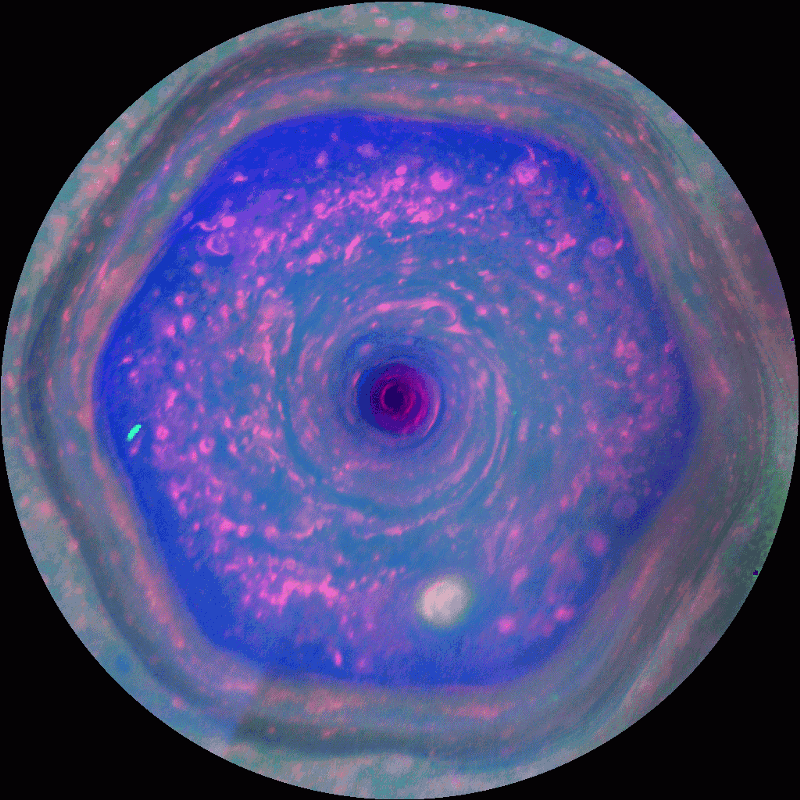
Saturn’s polar storm itself is some 1,250 miles (2,000 kilometers) in diameter, and has remained continuously over the 13 years that Cassini has observed it. What’s been, perhaps, most remarkable of all is that, beginning in the last few years, the color of this vortex has begun to change. As scientist John Blalock notes:
When we look from 2012 to 2016, [the] hexagon is maybe a little brighter, but the interior and especially the doughnut region [at the center] looks brighter. [The] brightening is consistent with an increase in the production of photochemical haze products in the upper atmosphere.
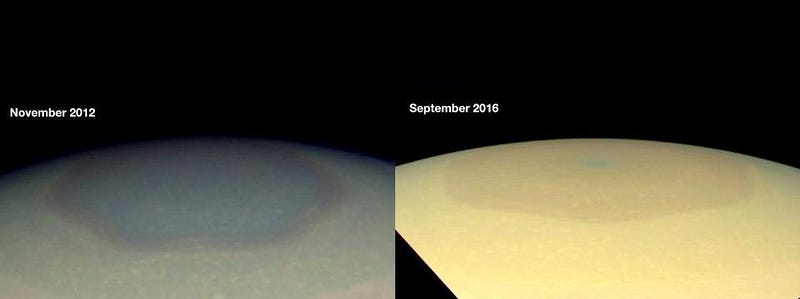
The leading theory as to why? The Sun itself. The north pole of Saturn has long been tilted away from the Sun, and only came back towards the Sun as 2015 approached. By 2016, it was very clear: the color of the polar hexagon had changed, as it found itself in direct sunlight. With a 29 year orbital period around the Sun, there was no way Cassini could have seen this change sooner, and it’s only thanks to the extended duration of this mission that we found this out at all!
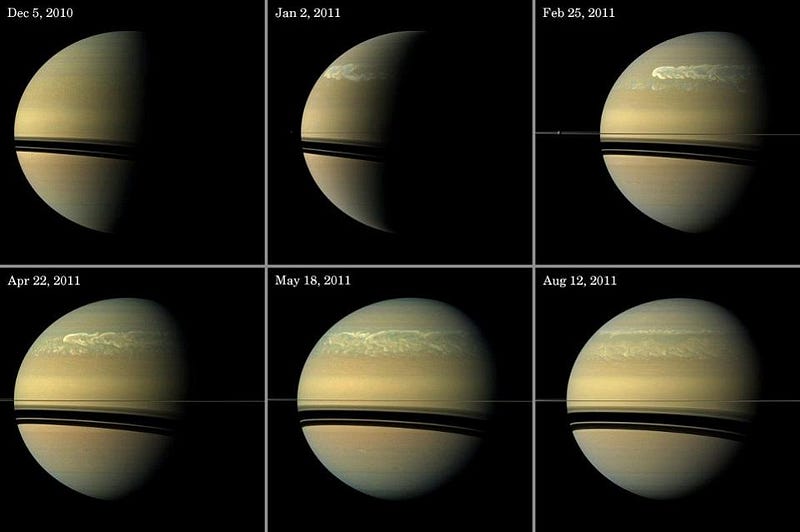
2.) The largest storm ever known in the Solar System. Like all the planets with atmospheres, Saturn contains its own weather, complete with storms both large and small. While the Cassini mission was able to discover a number of interesting ones on the ringed-world, such as the long-lived polar hexagon and the Southern hemisphere’s Dragon Storm, the most spectacular occurred in 2011, emerging in the northern hemisphere, encircling the entire planet, lapping itself and lasting over 200 days. Images taken as close together as one rotation apart showed that the storm migrated across the Saturnian surface at 60 miles per hour (100 km/hr).
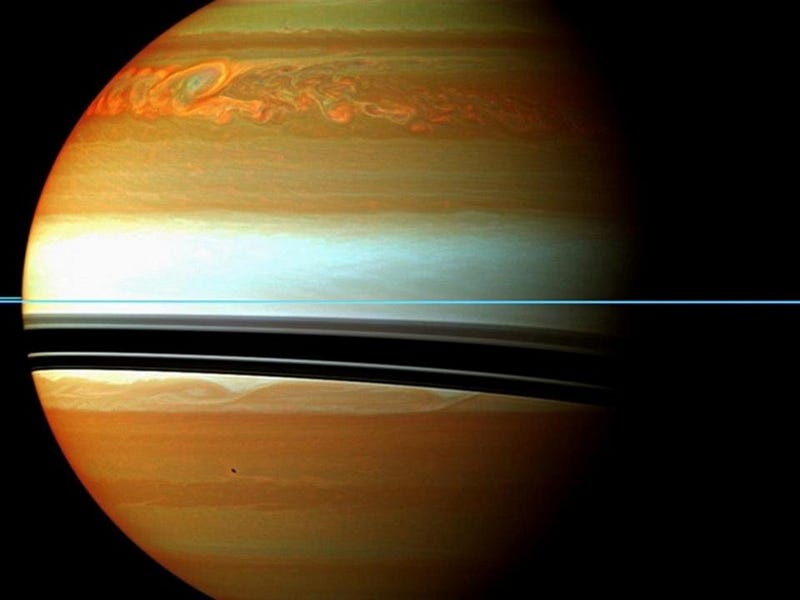
While a handful of storms of this magnitude have been observed every 20–30 years or so dating back to 1876, this was the largest, longest-lived one. In April, we found these storms are suppressed by water vapor in the lower layers of Saturn’s atmosphere. Being heavier than not only hydrogen and helium but also methane, the wet water vapor forms a layer underneath Saturn’s outer exosphere, insulating the inner part of the world. Eventually, the outer layers cool so much that they sink, allowing the inner, wet layers — and storms — to re-emerge. Having developed this picture from Cassini’s true and false-color images, the next major Saturnian storm, predicted for the 2030s, could finally teach us how much water our ringed neighbor contains.
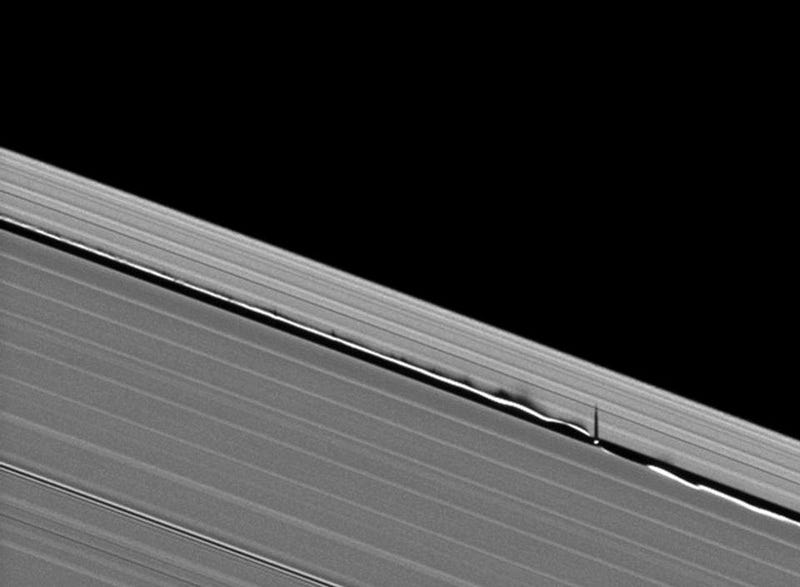
3.) The structure, ripples, and relief inherent in Saturn’s rings. Saturn is remarkable in a number of ways; among all the planets we know of, it’s the least dense, and also the only one with a spectacularly visible set of rings. Composed of icy, dust-like material, these rings aren’t solid, but made up of particles that pass each other, sticking together briefly and torn apart by tidal forces. Snowballs and planetesimals coalesce, only to be torn apart by tidal forces exerted by Saturn and its passing moons.
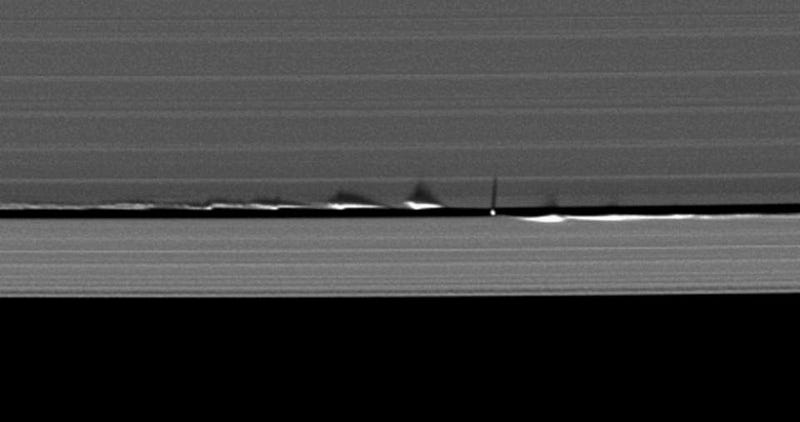
The ring system itself is just 10 meters to 1 kilometer thick all the way through, and may be as old as Saturn itself. When Saturn’s rings are viewed edge-on, thanks to the angle the rings make with the Sun, the tiny imperfections in the ice crystals can be seen to cast fascinatingly long shadows across the remainder of the rings themselves.
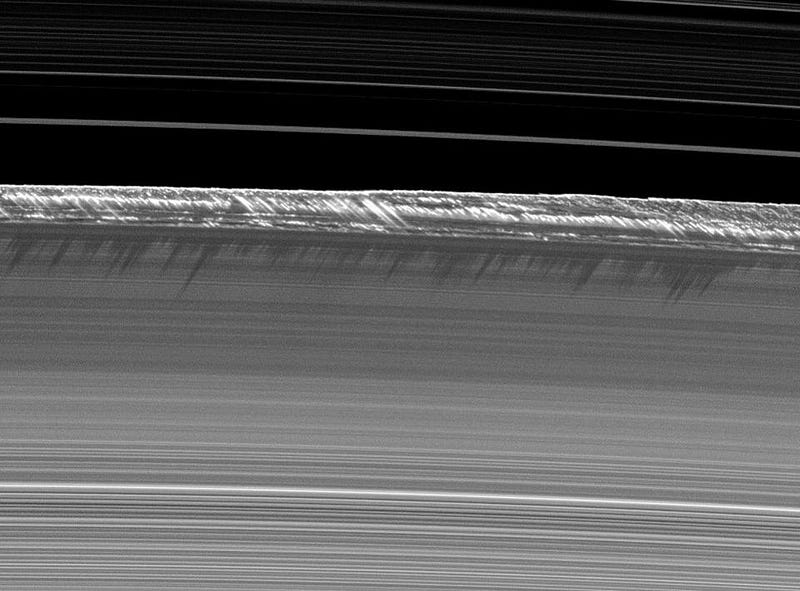
The main rings extend from 7,000 km to 80,000 km above Saturn’s equator: larger than Saturn’s radius. Composed of 99.9% water-ice, the ring system has thousands of thin gaps, and was thicker and more varied in the past. The once-rocky material has coalesced into moons, but the watery rings will remain for as long as our Solar System exists.

Although they’re highly reflective and made mostly out of water-ice, the rings exhibit varying amounts of reflectivity in the optical and in the radio, with the latter allowing for much sharper imaging than the former.
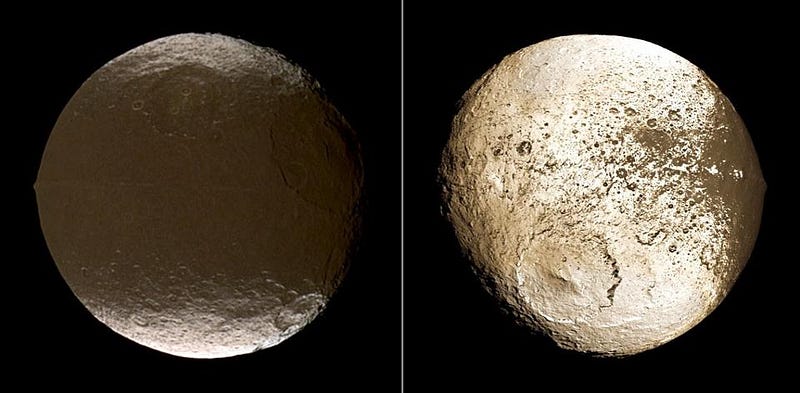
4.) The mystery of Iapetus’ two-toned nature was solved. Iapetus was the second moon of Saturn ever discovered, and arguably became its most mysterious. Not only does it have an equatorial ridge and a large orbital tilt, but one half of it is as reflective as ice, while the other half is 80% darker. What makes Iapetus two-toned? Not the inclination of its orbit, but the fact that it’s the farthest large moon from Saturn. That, and the presence of another, also remarkable moon even farther out.
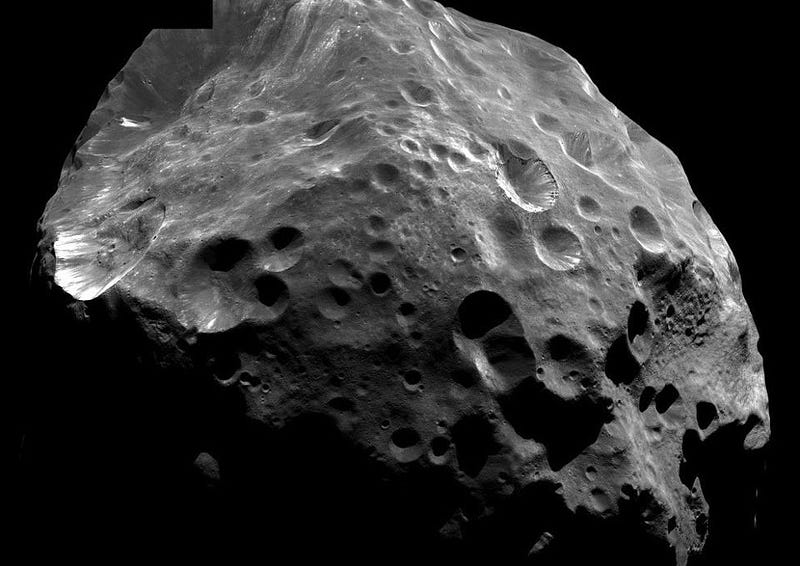
Well beyond the orbit of Iapetus lies a moon that looks like none of the others orbiting Saturn: Phoebe. Phoebe isn’t made up of the same materials that Saturn’s other Moons are, and moreover, it orbits in the opposite direction from all the others. Rather than (looking down from the north pole) orbiting counterclockwise around its parent planet, which all the other moons do, Phoebe revolves clockwise around Saturn. How is this possible? Because Phoebe didn’t originate with Saturn, but is rather a captured Kuiper belt object! In addition, Phoebe is responsible for the largest, most elusive ring in the Solar System.
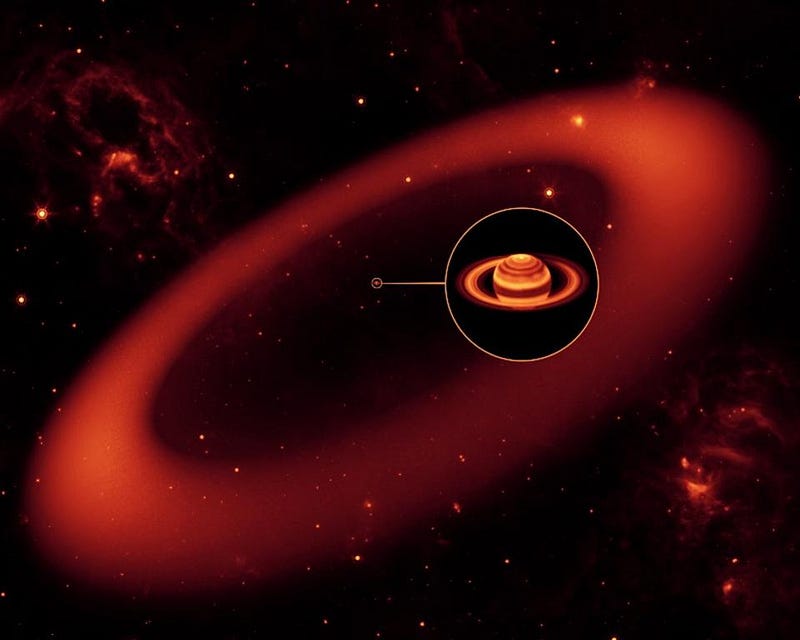
Only detected in 2004 with the (infrared) Spitzer Space Telescope, the Phoebe ring is a diffuse ring of debris that originates from Phoebe, and is extremely dark. It’s also incredibly sparse: the material comes at a density of about seven dust-sized grains per cubic kilometer! Of course, since this debris revolves around Saturn in the opposite direction to all the other moons, the outermost moons of Saturn might plow into it, exposing the leading side of that moon to that darkened debris. That’s exactly the configuration we’ve got with Iapetus, slamming into Phoebe’s debris ring!
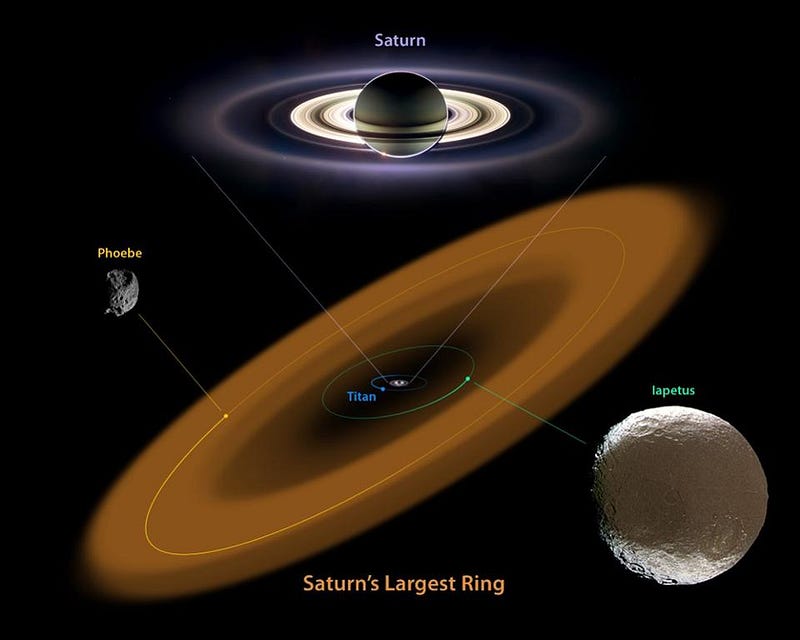
Since Iapetus is tidally locked to Saturn — meaning that the same “side” always faces forward as it moves through its orbit — the front of it accumulates this dark material, while the rear side doesn’t. The darker material, collected on one side of Iapetus, gets hotter than the lighter material, and this causes the surface ice to sublimate. In that gaseous phase, that vapor has a significant amount of kinetic energy. Not enough to have it escape Iapetus’ gravity, but enough so that it can migrate to the light side, where it stably remains, causing the two-toned nature of Iapetus. It was the spectroscopic capabilities of Cassini that provided the keys to unlocking this mystery.
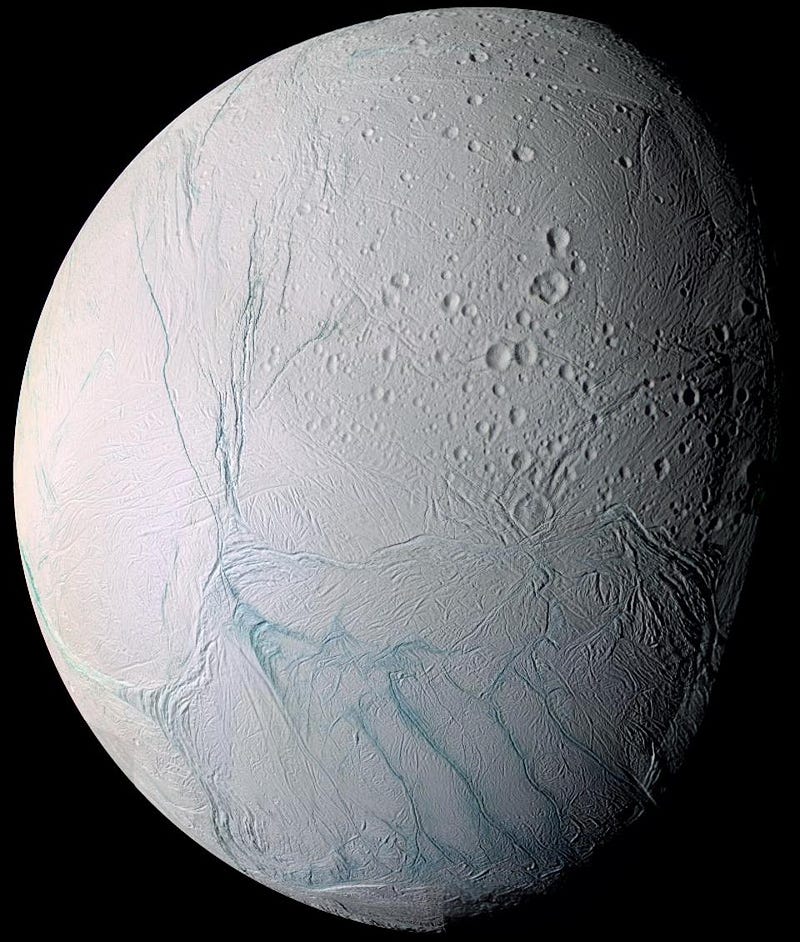
5.) The potential of Enceladus to house life in a subsurface ocean. As imaged by Cassini, Enceladus was found to have a surface of smooth, bright ice. So bright, in fact, that it holds the record as the most reflective moon in the Solar System. But this smooth surface exhibits cracks all throughout it, with the fissures indicating weak points in the icy surface. Enceladus is located right at the center of Saturn’s E-ring, and this is no coincidence; it’s responsible for the ring’s creation!
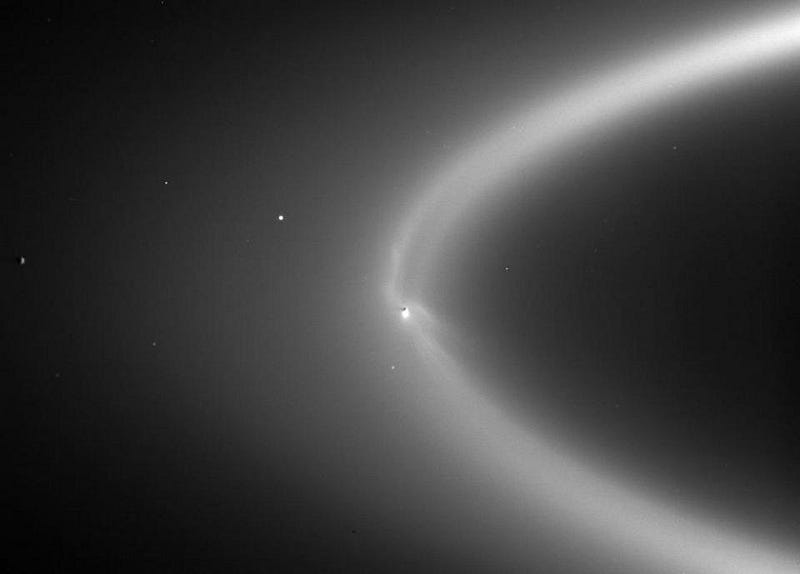
The icy material from beneath Enceladus’ surface is compressed and heated by the ice atop it and Saturn’s tidal forces, creating a subsurface ocean of briny, liquid water. That water is then ejected with such force that it escapes from Enceladus’ gravity, where much of it forms the reflective E-ring. The presence of water, warmth, and organic molecules all ought to exist on Enceladus, making it one of the most likely candidates for life in our Solar System.
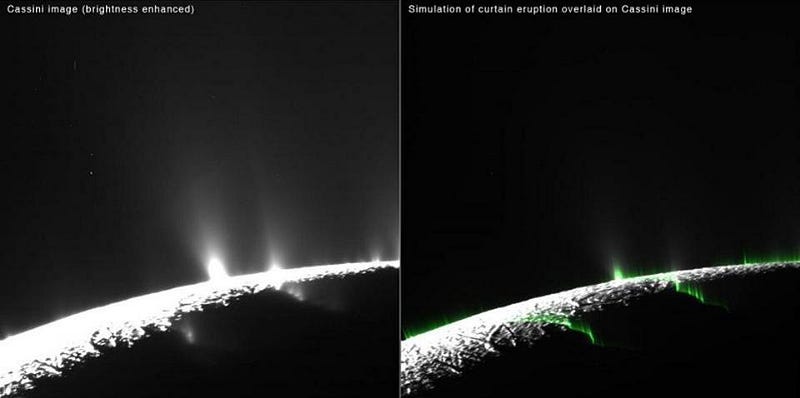
Water is proven to exist, while the tidal forces from Saturn provide the necessary heat. Based on observations of other bodies in the Solar System, Enceladus likely contains the raw ingredients for life as well. The suspected existence of all three hints at the possible presence of the precursors to amino acids in this vast subsurface ocean.
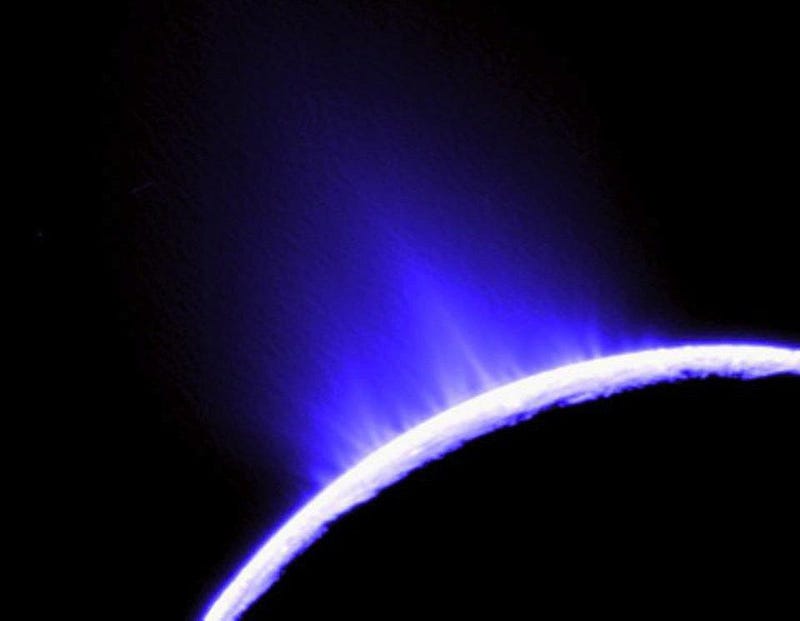
These geysers may even make ideal targets for future missions that search for the existence of extraterrestrial life. A spacecraft that flew through the geyser’s plumes, collecting the ejected material, may well find the organic material that humans have been hoping exist since we first dared dream of other worlds. The ingredients are all in place. The possibility is too great to ignore.
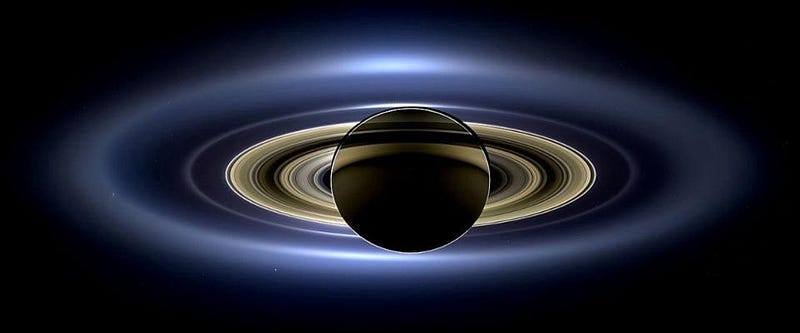
6.) And finally, we re-discovered the Earth. As it journeyed out of the Solar System, Voyager first took the famed “pale blue dot” image. From behind the shadow of Saturn, shielding Cassini from the Sun, it looked back towards Earth as it snapped this photo. While the rings and atmosphere of Saturn itself were brightly illuminated, one point of pale blue light stood out against all the rest. This wasn’t an image of a distant star, nor of a tiny Saturnian moon. Instead, that dot was our home: Earth.
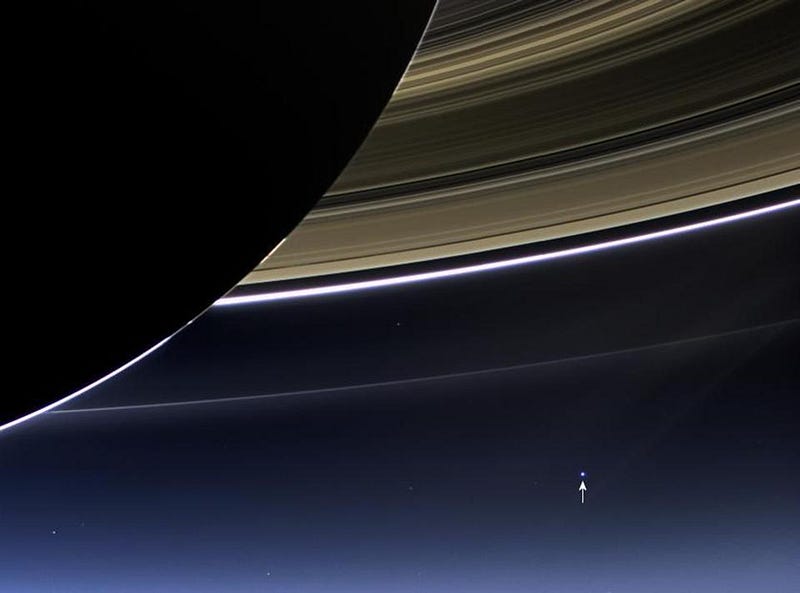
The tiny, asymmetrical smudge on the right side of that dot isn’t just an image artifact, but comes about from our own companion world: the Moon. After a 20 year journey and countless discoveries, it’s arguable that the greatest thing ever brought to us by Cassini was the most inevitable and simple of all: a view of our own home. Cassini took its final dive into the gas giant’s atmosphere just days ago, on Friday, September 15th, but it’s important to remember how far we’ve come, and how we got there. Our journey is not yet complete, as the next steps forward are up to all of us.
Ethan Siegel is the author of Beyond the Galaxy and Treknology. You can pre-order his third book, currently in development: the Encyclopaedia Cosmologica.





